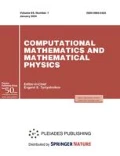Abstract
New formulations of the optimal control problem for metal solidification in a furnace are proposed in the case of an object of complex geometry. The underlying mathematical model is based on a three-dimensional two-phase initial-boundary value problem of the Stefan type. The formulated problems are solved numerically with the help of gradient optimization methods. The gradient of the cost function is exactly computed by applying the fast automatic differentiation technique. The research results are described and analyzed. Some of the results are illustrated.
Similar content being viewed by others
References
A. F. Albu and V. I. Zubov, “Mathematical modeling and study of the process of solidification in metal casting,” Comput. Math. Math. Phys. 47, 843–862 (2007).
A. F. Albu and V. I. Zubov, “Optimal control of the solidification process in metal casting,” Comput. Math. Math. Phys. 48, 805–815 (2008).
A. F. Albu and V. I. Zubov, “Determination of functional gradient in an optimal control problem related to metal solidification,” Comput. Math. Math. Phys. 49, 47–70 (2009).
A. V. Albu and V. I. Zubov, “Choosing a cost functional and a difference scheme in the optimal control of metal solidification,” Comput. Math. Math. Phys. 51(1), 24–38 (2011).
A. V. Albu, A. F. Albu, and V. I. Zubov, “Functional gradient evaluation in the optimal control of a complex dynamical system,” Comput. Math. Math. Phys. 51, 762–780 (2011).
A. V. Albu, A. F. Albu, and V. I. Zubov, “Control of substance solidification in a complex-geometry mold,” Comput. Math. Math. Phys. 52, 1612–1623 (2012).
A. F. Albu and V. I. Zubov, “On the influence of setup parameters on the control of solidification in metal casting,” Comput. Math. Math. Phys. 53, 170–179 (2013).
A. Albu and V. Zubov, “On the controlling of liquid metal solidification in foundry practice,” Operations Research Proceedings 2011: Selected Papers of the International Conference on Operations Research (OR 2011), August 30–September 2, 2011, Zurich, Switzerland, Ed. by D. Klatte, H.-J. Lüthi, and K. Schmedders (Springer, Berlin, 2012), pp. 3–8.
A. V. Albu and V. I. Zubov, “Investigation of the optimal control problem for metal solidification in a new formulation,” Comput. Math. Math. Phys. 54, 756–766 (2014).
Yu. G. Evtushenko, “Computation of exact gradients in distributed dynamic systems,” Optim. Methods Software, No. 9, 45–75 (1998).
Author information
Authors and Affiliations
Corresponding author
Additional information
Original Russian Text © A.F. Albu, V.I. Zubov, 2014, published in Zhurnal Vychislitel’noi Matematiki i Matematicheskoi Fiziki, 2014, Vol. 54, No. 12, pp. 1879–1893.
Rights and permissions
About this article
Cite this article
Albu, A.F., Zubov, V.I. Investigation of the optimal control of metal solidification for a complex-geometry object in a new formulation. Comput. Math. and Math. Phys. 54, 1804–1816 (2014). https://doi.org/10.1134/S0965542514120057
Received:
Published:
Issue Date:
DOI: https://doi.org/10.1134/S0965542514120057


